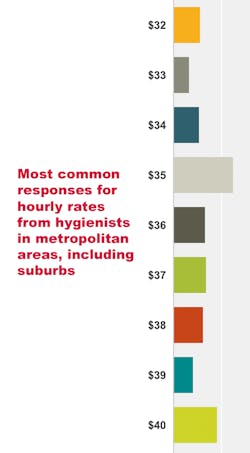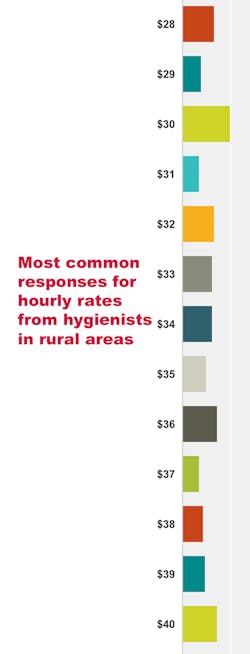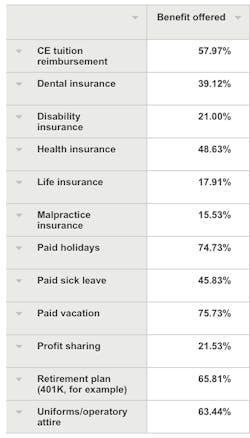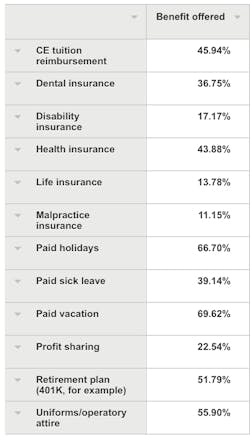RDH eVillage Salary Survey, part 3: Comparing urban vs. rural hygienists
We would like to open the floor to a Missouri dental hygienist, whose comments below epitomize many of the concerns expressed in salary surveys of dental hygienists. The hygienist did not work in either St. Louis or Kansas City. A 1980s graduate from a dental hygiene school, the hygienist works 25 to 30 hours a week and is happy with her schedule.
On Sept. 15, she wrote in her own response to the 2014 RDH eVillage salary survey, “We have a hygiene opening in our office for three days a week. Many of the applicants are May 2014 graduates from the local two-year hygiene program, and have not found positions yet. The applicant we are leaning toward is leaving her position of eight years as her group has laid off four staff in the last year, including a hygienist.
“Two former hygienists of our office who moved away several years ago but have returned to the area have not been able to find a position. They need five days a week. Therefore, they are not interested in returning to our office, although three days is looking better than no days.
“In my opinion, our profession and our lobbyists need to wake up. Our office has lost 20-plus families this year [100-plus patients] because of PPO plans. Because of dental offices feeling forced into accepting PPO plans and the low reimbursement of these plans, hygiene salaries are stagnant and stalled. We can blow smoke up our skirts and be in denial about the 'importance' of our profession but bottom line we are all replaceable and money, particularly insurance plan coverage, is what it is about.”
In this third installment of the 2014 RDH eVillage salary survey, we are comparing statistics of the urban vs. rural dental hygienists. Specific statistics for 15 U.S. cities can be viewed below. The first and second installments of the survey results can be viewed here:
RDH eVillage Salary Survey, part 1: Hygienists still think jobs are scarce
RDH eVillage Salary Survey, part 2: Hygienists wary of job benefits continuing
Profile of the rural hygienist
Overall, 764 of the respondents to the survey indicate that they practice in a small town or rural area, and 55% work more than 30 hours a week. Only 18% indicated that they would “prefer” to work more hours than scheduled.
Rural hygienists say it is “very difficult” (48%) or “somewhat difficult” (40%) to find a dental hygiene position in their area. Seventy-eight percent say “too many graduates are looking for work” in rural areas, too, indicating that the oversupply of licensed dental hygienists filters out to less populated areas,.
“There are no hygiene jobs available in our area or surrounding areas. Resumes have been out for three years with no luck,” a Mississippi hygienist noted.
A New Hampshire hygienist added, “Many hygienists in our area are sticking with their employer, even if we don't agree with office policies or pay because there are no alternatives, as opposed to five to 10 years ago when many dentists were competing in a limited market.”
Nationally, 40% of rural hygienists projected their 2014 annual income to fall into the $40,000 to $60,000 range, and 78% earn income based on an hourly rate system provided by employer. Twenty-eight percent received a pay raise within the last year, and an additional 26% have received a raise within last two years.
Profile of the urban hygienist
Overall, 1,011 of the respondents to the survey said they practice in metropolitan areas, including suburbs, and 53% work more than 30 hours a week. Only 19% “prefer” to work more hours than “typically” scheduled.
Urban hygienists say it is “very difficult” (44%) or “somewhat difficult” (40%) to find employment as a dental hygienist. As with the rural hygienists above, 78% believe “too many graduates are looking for work.”
A recent graduate in Madison, Wis., said, “It sucks! I feel like we aren't appreciated and seen as easily replaced [due] to saturation of hygienists. No paid holiday, vacation, or sick time is so wrong! If I knew than what I know now, I would have picked a different career path! Really disappointed!”
Nationally, 54% of urban hygienists projected earning $40,000 to $70,000 in their profession during 2014, and 78% earn income based on an hourly rate system provided by employer. The frequency of pay raises for urban hygienists is a little lower than for the rural hygienists above: 24% received a pay raise within the last year, and an additional 20% received a raise within last two years.
A Los Angeles hygienist added, “While it continues to be frustrating to not receive raises after being a hard-working, loyal employee, I am grateful that I work for two employers who are verbally appreciative and overall good people. Of course, I'd love to make more money, but there are economic issues affecting us.
“I hope they will consider giving us raises when we ask, but I agree with many other hygienists in saying that our bosses know that jobs are scarce, and pay rates are staying stagnant. So I feel that we're stuck until the economy really gets to a better place. And that may not happen for awhile. It is frustrating, but in the big picture, I'm definitely grateful for my job.”
Pay rates in urban vs. rural areas
The most common pay rate for dental hygienists practicing in metropolitan areas in the United States is $35 an hour. In rural settings, the most common hourly rate is $30 an hour. Of course, common hourly rates depend on the region; RDH eVillage will present a state-by-state breakdown of dental hygiene salaries in an upcoming issue. The range for common hourly rates is greater among rural hygienists (see charts above).
Benefits in urban vs. rural settings
The two charts above depict the percentage of dental hygienists who have access to a job benefit offered by a dental practice, regardless of whether they enroll for the benefit. The chart on the left is for hygienists in rural areas or in small towns; the chart on the right is for hygienists who practices in the larger metropolitan areas.
For the most part, dental hygienists in the rural areas enjoy better benefit packages.
A closer look at 15 cities
The 15 cities below provided enough responses to offer a more detailed look at the income ranges and benefits offered in these cities. Click on the image for a closer look.
About the Author

Mark Hartley
Mark Hartley is the editor of RDH magazine and collaborates with Kristine Hodsdon on many of the articles for RDH eVillage, which also appear on DentistryIQ.com.



















